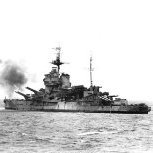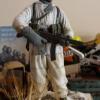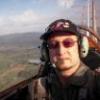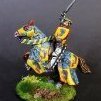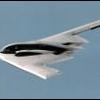-
Posts
2,035 -
Joined
-
Last visited
About roma847

Profile Information
-
Gender
Male
-
Location
Filderstadt, Germany
Recent Profile Visitors
4,029 profile views
roma847's Achievements

Very Obsessed Member (5/9)
3k
Reputation
-
Hello everybody, Brevity is the soul of wit! By using the laboriously determined dimensions of the cladded rod systems I've created this drawing on a scale of 1:1, with the help of which I can now first cut the claddings of the rod systems. For the rods themselves I will use steel wire (Ø 1 mm). That's it for today, I have to go to bed sooner again.
-
Hello everybody, I still found a better material for the dark covering of the probe sides and rod systems. I had an appetite for After Eight once again, and when I unpacked it I had the little wrappers between my fingers and immediately thought Eureka - I have it! The outside of the cases is matt black and the inside is glossy. And after I've crumpled up and then unfolded it again I think that this variant is the best solution. Then I thought about how best to scratch the foot of the X-Band High Gain Antenna, but so far I haven't been able to find a useful photo that would show it in more detail. Since you can hardly see the base anyway, I first cut a small cylinder out of a discarded ballpoint pen and stuck it under my existing antenna, what I also wanted to cover with aluminum foil. Then in this image it almost looked to me as if there was a cone-shaped cover beneath the antenna, which is why I've enlarged it again, which seems to confirm my suspicion. That's why I covered this paper lampshade with foil, and glued from below over the base against the bottom of the antenna. Here the antenna, covered in this way, is only temporarily placed on the probe, but that still doesn't convince me. As one can clearly see on this model, the entire lower part of the antenna is loosely covered with dark foil. That's why I'm going to rethink the entire cladding of the space probe including the rod systems and use both shiny aluminum foil and the After Eight paper.
-
Hello everybody, and since I've just gotten my head around my approved scaling procedure again, I want to continue straight away and have done the same on the opposite side with the narrower rod, which is also covered with foil. It is always important to define a reference dimension for scaling all other dimensions, in this case the height of my model probe body. In addition to the dimensions of the rod systems, I also have the dimensions of the Deep Space Optical Communications (DSOC) System and the two probe engines (Hall-effect Thrusters) determined. The DSOC dimensions can be determined a little more precisely in this image, which is why a plausibility analysis is still advisable between similar images to select the final dimensions. At this point I would like to point out to anyone interested this video image (1:36:22), where based on this model the individual parts of the Psyche probe, are explained clearly, which was very helpful for me in terms of overall understanding. If you want to watch the whole video from the beginning, you should skip the meaningless opening credits by clicking the next linked image and scroll to this point at the timeline (1:30). On the back of the probe there is this covered transverse rod system, which connects the two side rod systems. With these dimensions I can now create assembly sketches for all three the rod systems and for the claddings. And then we'll see.
-
Hello friends, the longer I look at the greatly simplified Solar probe body from the Paper Kit and compare it with NASA photos and videos, the more things I notice that I don't like yet, which is why I decided to scratch several details that were only printed and thereby refine the probe's outfit a little. The X-Band High Gain Antenna shown in the kit as a flat cone actually has, like all space probe antennas, an inwardly curved, concave shape and is covered by a foil, whereby it because of the three struts underneath just appears as a flat cone, which I have already covered by gluing on aluminium foil. That's why I first stuck over the blue outline of the antenna on the top of the probe, which is simply wrong there and is just irritating. But I could have saved myself that, because as you can see on NASA videos, the sides of the probe body are partially covered with reflective silver and black foil, which is why I came up with a new idea. And since I like to use different materials, I looked for suitable stuff in my stocks and found some too, such as: 1 Aluminum household foil, smooth, shiny front 2 Aluminum household foil, heavily creased, matt shiny back 3 Aluminum household foil, slightly wrinkled, matt shiny back 4 Plastic film (robidog.com), , is certainly familiar for German dog owners. 5 Construction paper, black, smooth 6 Construction paper, black, slightly creased Now I just have to decide, although I'm leaning towards aluminum foil and paper because it's easier to glue. Then I looked closer at the rod constructions at the two corners, which are also covered, but I still have to take a closer look at them. At the top of the wider construction there is a Gamma-ray spectrometer for analyzing Gamma-ray spectra. In order to be able to scratch these constructions, I first have to determine their dimensions, which is known to be a stressful business of measuring and scaling based on a reference dimension, At least I've already started with the wider construction. The one on the opposite side is narrower, for whatever reason. Source: Arizona PBS This will be another stressful torture for my eyes again, but don't panic, they always survived it so far.
-
Hello everybody, today I dared to the cross struts (brass wire Ø 0,5 mm), but gluing them in turned out to be extremely difficult, which required a lot of sensitivity. The top priority when gluing was a secure bearing and locking of the probe and panels so that nothing could slip. Since the gluing had to be done with UHU CA, the strut could initially only be glued on the rear side. So that after the strut moistened with CA had been positioned accurately, it could be carefully placed on the front side after a short time to set, I glued a tape strip there as a shelf, what has also proven successful. After carefully removing the tape strip, the strut could also be glued at this point by dabbing it with CA using an acupuncture needle. The small triangular strut on the probe wall was then glued onto the struts, wherewith this side was completed. The crossbar on the other side was glued in the same way. Maybe you probably haven't noticed yet, I've colored the white edging of the middle panel area blue, which I like better that way.
-
Hello everybody, today was the day, and when I've turned the probe around full of curiosity I was pleasantly surprised that both Solar panels remained almost horizontal, especially since both were only glued on one brass strut, wherewith my idea actually proved to be a viable solution. In Step 6 the side wall could now be glued, and then also the top finish (Step 7). However, I don't like the blue X-Band High Gain Antenna yet, and since it is covered with foil in the original probe anyway, I tried that too and cut the part out of thin aluminum foil. I then stuck the foil with CA onto the cone, which looks better to my taste. However, I will not glue the X-Band Antenna firmly onto the probe until later, as I would like to add a few details that have so far only been hinted at in the paper kit. I've then turned the probe over again and glued the remaining brass struts onto the undersides of both panels. Now that both panels were sufficiently stabilized, I turned everything over and took a closer look at all again. Afterwards I decided to remove the paper covers of the struts because this look corresponds more to the original and will only glue the downscaled front covers, which I've scaled from the video shown at the beginning. Source: Official NASA Trailer (2:00) Now the crossbars are still missing on both panels, which I have therefore already removed from the kit and will also replace with brass wire, as well as some details such as the Rod systems in the two corners, as well as Thruster and Spectrometer, which I could possibly hint at.
-
Hello everybody, let's continue with the Solar panel on the other side, whereby I changed the assembly sequence a little bit. First I glued the longer leg of the brass strut up to the bend onto the underside of the panel. And then it went to the Styrofoam platform, in order to thread the strut, hoping that everything would work. To ensure the panel had a sure laying, I had to put another block of Styrofoam underneath. I then carefully threaded the front end of the brass strut with tweezers a few millimeters into the tiny opening on the side wall, then slowly pulled across the Balsa support to the other side wall and carefully pushed through the opening there until it could be seen on the other side. So far so good! After that, however, it became increasingly difficult as the bend in the brass support had to go through the wall and I had to be extremely careful not to bend everything, especially since the front end behind the other wall had also to be pulled at the same time, which was quite tricky. But finally I have succeed in doing it, and was able to take a little breather. Then I still glued the wires to the Balsa support on both sides with UHU CA. Additionally I then still glued a Channel profile (1,5 mm x 3 mm) onto it to make sure that the glued wires would not get loose if I would have to bent the finally glued panels a little for position correction. Tomorrow the steps 6 and 7 can also follow now, whereby the last side wall and the ceiling will be glued. And then I'm already excited to see what everything will look like when I turn the space probe over to glue the struts onto the undersides of the panels too.
-
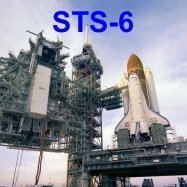
Space Shuttle Launch Pad 39A with Challenger STS-6
roma847 replied to roma847's topic in Work In Progress - SF & RealSpace
Thanks my friend for your interest and the nice words. The External Tank will be airbrushed with different shades of orange. Keep cool and take enough time and popcorn for going through the whole report page by page.- 2,528 replies
-
- 1
-

-
- Space Shuttle
- Launch Pad 39A
-
(and 4 more)
Tagged with:
-
Hello everybody, and now to the assembly order, which I thought carefully about. Since my two Z-shaped brass struts are supposed to go through the probe cube, it quickly became clear that I wasn't allowed to glue the cube together on all sides yet otherwise it would not be possible to thread the struts through. That's why in the following picture I tried to mark the individual steps in order with arrows, which may not be understandable straight away, which is why I would like to briefly explain the steps. In order to still have enough freedom of movement when threading the struts, I can in the 1st Step first just only glue the two rear side walls to the floor and the Balsa support. In the 2nd step I only glued the end of the brass strut onto the back of the upper panel with UHU CA, because I might want to leave out the white paper triangle. In order to be able to handle these bizarre structures when threading through the struts, I cut two Styrofoam blocks to the required height to support the panels. In the 3rd Step then followed the careful threading of the glued strut first through the front side wall and then by turning the rear support so that the strut could also be threaded into the rear side wall and then could carefully pulled through, which actually worked. The other panel is only temporarily placed in these images. With this panel and the Steps 4 to 8 it will continue tomorrow.
-

Space Shuttle Launch Pad 39A with Challenger STS-6
roma847 replied to roma847's topic in Work In Progress - SF & RealSpace
Hello everybody, in contrast to my last post, today is again a day of joyful remembrance of Challenger's maiden flight STS-6 41 years ago, Source: retrospaceimages.com (STS-6) L-R: Donald Peterson †, Paul Weitz †, Story Musgrave, Karol Bobko † Source: wikipedia.org to which I have dedicated my long-term project, with which I'm going already into the 13th year, hard to believe, but true. BTW 13 is my lucky number, also because my son Andreas was born on a Friday, April 13, 1979. With this in mind, I hope to make a lot of progress with my project this year.- 2,528 replies
-
- 2
-

-
- Space Shuttle
- Launch Pad 39A
-
(and 4 more)
Tagged with:
-
Hello everybody, first of all, I still wish everyone a Happy Easter. During my trip to Florida, I witnessed the launch of a Falcon 9 Heavy for NASA's Psyche mission from Launch Pad 39A live from the Viewing point of the Apollo Saturn V Center on October 13, 2023, which was an unforgettable experience that I reported on in my German Travel report. This Official NASA Trailer gives a very good overview of the Psyche spacecraft and its mission. Source: NASA, JPL-Caltech, ASU As I mentioned at the end of the post, one could take along a simple paper kit of the Psyche spacecraft in the KSC Visitor Complex, which even contains short illustrated instructions, so putting it together shouldn't be rocket science. But when I took a closer look at the kit and the instructions, I immediately had some concerns about the 15 cm long Solar arrays and their point-like attachment to the space probe. To do this, a folded and glued carrier strip (5 mm x 200 mm) should be glued in the middle of a folded panel and pushed through side slits through the space probe body, onto which then at the other side the other panel should be glued. As one can see, the space probe only consists of six parts, which I first cut out of the slightly thicker cardboard. Then one can clearly see that for the intended assembly of the panels with the help of the carrier strip, the inner areas of the filigree struts must not be cut out in order to provide the whole thing with sufficient support, which of course doesn't correspond to the original and would be totally resist me, as one can see in the Trailer (2:00). That's why I came up with a different, even though adventurous solution, that should come closer to the original. The only problem is the virtually point-like, stable attachment of the widely overhanging panels to the space probe walls. Of course, it would be ideal if I made the struts out of thin wire, which is why I first cut out the spaces, but what was quite tricky. To bend the struts, I first had to make a sketch, which I then used to bend brass wire (Ø 0,5 mm) into a double Z shape. I could then first glue these struts on one side of each of the separate panels and push them through the side slots through the probe cube. Separate panels because the relatively stiff cardboard would probably be difficult to glue with inserted struts. Then I've still thought about a Balsa support that is glued to the interior of the space probe, onto the top of which the middle parts of the struts are glued to ensure that they are held in place adequately. Now I just have to think of a clever sequence of assembly steps, whereby I can thread the struts of the panels glued on one side individually and one after the other and only then can glue them to the panel parts on the other side, before I can finally glue the space probe cube. If the whole bizarre structure had sufficient stability and rigidity, I could perhaps even leave out the paper strips of the rod systems that are actually too wide, which would then be even closer to the original. As one can see, a lot of things are still formulated in the subjunctive, therefore Trial & Error, let's see what can be done.
- 10 replies
-
- 12
-

-

Space Shuttle Launch Pad 39A with Challenger STS-6
roma847 replied to roma847's topic in Work In Progress - SF & RealSpace
Hi Theb, and thanks for your nice compliments. As long as I live, it can be seen during an annual Open House in my house in the Filder Space Center (FSC) in Filderstadt, and then one will see, perhaps in the Technik Museum Speyer, where the Russian Space Shuttle Buran is also located. Stay tuned, the show must and will go on!- 2,528 replies
-
- 1
-

-
- Space Shuttle
- Launch Pad 39A
-
(and 4 more)
Tagged with:
-

Space Shuttle Launch Pad 39A with Challenger STS-6
roma847 replied to roma847's topic in Work In Progress - SF & RealSpace
Dear friends, this year too, let us stay for a moment in silent memory the memorable day in 1986 of the Challenger accident 38 years ago and together remember the crew of the STS-51L mission, Source: NASA which ended in a disaster 73 seconds after lift-off, in which the Challenger Crew lost their lives ... Front: Michael Smith, Francis Scobee, Ronald McNair; Back: Ellison Onizuka, Christa McAuliffe, Gregory Jarvis, Judith Resnik Source: wikimedia.org May they rest in peace - Keeping their legacy alive forever.- 2,528 replies
-
- 4
-

-
- Space Shuttle
- Launch Pad 39A
-
(and 4 more)
Tagged with:
-

Space Shuttle Launch Pad 39A with Challenger STS-6
roma847 replied to roma847's topic in Work In Progress - SF & RealSpace
Hello friends, and sorry guys, I'm still too busy with my travel report at the moment, which is quite time-consuming. To bridge the gap, I can offer the Raumcon link for anyone interested, but unfortunately only in German. But maybe you can have it translated or just look at the images and videos, that will be enough entertainment, I think, until I'll continue with the Payload Canister. Trip to Florida and visit to the KSC 2023 Enjoy all and have a little bit fun.- 2,528 replies
-
- 1
-

-
- Space Shuttle
- Launch Pad 39A
-
(and 4 more)
Tagged with:


